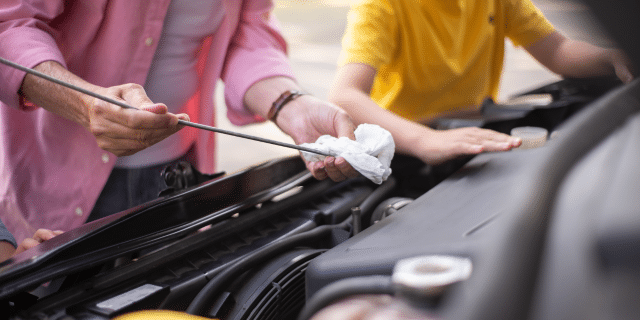
by California Casualty | Educators, Helpful Tips |
The first day of school can feel like stepping onto a stage—new faces, new routines, and a swirl of emotions. For kids, it’s both exciting and nerve-wracking; for parents, it’s a delicate balance of encouragement and letting go. By helping your child manage those first-day jitters, build independence, and embrace challenges with a growth mindset, you can set the tone for a year filled with confidence and curiosity.
Here are some simple ways to help your child feel ready—emotionally and practically—for the year ahead.
Listen—Really Listen—to Your Child
Back-to-school season is a big transition, and change can be unsettling. Ask your child how they’re feeling about the new year. Are they excited to see friends? Nervous about a new teacher? Unsure about tougher schoolwork?
Validate those feelings. Let them know that it’s normal to feel a mix of emotions—and that even teachers feel that way sometimes. For younger kids, support might mean extra hugs, a comforting meal, or a favorite bedtime story. For older kids, try meditation, a walk together, or a phone call with a friend. The key is to ask what they need and follow their lead.
Help Them Acclimate Early
If your child is starting at a new school, attend an open house or schedule a tour so they can see the space beforehand. Arrange to meet the teacher(s) if possible. Encourage reconnecting with school friends before the first day. You might even want to join the parent-teacher association to connect with other families.
Build Skills Before Day One
Help your child feel ready for both academics and logistics.
- For middle schoolers, practice locker combinations. Buy an inexpensive combination lock for hands-on practice at home.
- Role-play scenarios like asking a teacher for help, changing classes, or joining a group activity.
- Work on skills like time management, organization, or social confidence.
Support Sleep and Nutrition
Kids learn and cope better when they’re well-rested and well-fed.
- Aim for 9–12 hours of sleep for younger kids and 8–10 hours for teens.
- Create a calming bedtime routine—dim lights, no screens and quiet activities like reading.
- In the morning, serve a balanced breakfast with protein, whole grains, and fruit, and pack healthy snacks to keep energy steady.
- Don’t forget a water bottle to stay hydrated throughout the day.
Make Sure They’re Fully Prepared
A little preparation goes a long way toward easing first-day nerves and setting your child up for success. Involve them in the process so they feel invested and ready to start strong.
- Finish summer assignments early to avoid last-minute stress.
- Shop together for school supplies so they can pick items they’re excited to use.
- Choose back-to-school clothes Let them select outfits that are comfortable and help them feel confident.
- See our money-saving tips for back-to-school shopping.
Ease into the New Routine
Talk through the school-day schedule for the whole family, from morning wakeups to after-school activities. A week before school starts, begin shifting bedtimes and wakeup times so the first day isn’t a shock.
Plan for a stress-free school morning:
- Lay out the first-day outfit (let kids choose).
- Pack the backpack and lunch.
- Allow plenty of time for dressing, hygiene, and breakfast.
Teach Positive Self-Talk
Help your child manage stress with healthy coping tools. Teach them a positive mantra, such as “I am strong. I belong. I can do this all day long” or “I am brave. I am bright. I can shine with all my might.” Have them say it out loud in front of a mirror as part of morning routine. Deep breathing, stretching, or quick mindfulness exercises can help calm first-day nerves. Child-friendly meditation apps, soothing soundscapes, or bedtime stories can also work wonders.
Manage Separation Anxiety
For younger children, reassure them that school is a normal and important part of life. Let them know exactly when you’ll be back for pickup—it’s comforting for kids to have a clear mental timeline.
Foster Age-Appropriate Independence
Small, age-appropriate responsibilities help kids feel proud, capable, and ready to take on more as they grow.
- Younger children can carry their own backpack and lunch.
- Older students can also make their lunch and plan their homework schedule.
- Remind kids about back-to-school traffic safety.
Create a Relationship Map
Draw a map with your child at the center, surrounded by trusted adults at school—teachers, counselors, aides—who can help. Knowing exactly who to go to makes asking for help less intimidating.
Check in with your child
At dinner or bedtime, ask open-ended questions like: “What made you smile today?” or “What was tricky?” These prompt more thoughtful answers than “How was your day?”
Watch for Signs of Struggle
If your child shows ongoing signs such as unusual sleep issues, irritability, poor concentration, low energy, loss of appetite, headaches, or frequent tears, consider reaching out to a school counselor or therapist for additional support.
By blending emotional support, practical preparation, and opportunities for independence, you can help your child start the school year with confidence and curiosity—ready to take on whatever comes their way.
This article is furnished by California Casualty, providing auto and home insurance to educators, law enforcement officers, firefighters, and nurses. Get a quote at 1.866.704.8614 or www.calcas.com.

by California Casualty | Educators |
You’ve got the keys, the blank slate, and a million Pinterest ideas—now what? If you’ve ever rearranged your classroom 14 times only to end up where you started or discovered that nothing will stick to your cinderblock walls, you’re not alone. Setting up your classroom is part science, part art, and part survival skills. Here’s how to make your space functional, organized, and ready for your best school year yet.
1. Start with a Floor Plan—on Paper
Save your back (and your sanity) by planning before you push a single desk. Measure your room and create a layout in Canva so you can test different setups—rows, clusters, flexible seating zones—without breaking a sweat. Keep the file handy so you can tweak it later in the year. Bonus: Take a stroll through your coworkers’ classrooms for fresh inspiration.
2. Be Strategic with Your Teacher’s Desk
Don’t just plop your desk in the front of the room because “that’s where it goes.” Think sight lines—you want to be able to see everyone from where you sit. Consider angling your desk in a corner and blocking the space behind it with brightly colored floor tape (students will quickly learn that’s a “no-go” zone). Check the view from the back of the room before committing.
3. Create a Teaching Station
Your teaching station is home base for lessons—a spot where your day’s materials are ready to grab. This could be part of your desk, or better yet, a separate area that keeps supplies organized and within reach. The less time you spend hunting for markers, the more time you have for teaching.
4. Master the Art of Storage
Clutter = chaos. Designate clear zones for students to pick up materials and turn in work. Keep frequently used items like pencils and paper within easy reach to reduce downtime. Use a labeling system for bins and shelves so everyone knows where things belong.
5. Tame the Tech
Before you finalize your setup, check outlet locations and plan how devices will be stored, charged, and returned. Use small strips of colored electrical tape to match devices with their chargers and spots at the charging station. Limited colors? Add patterns like stripes to stretch your system further.
6. Turn Down the Volume
A quieter classroom helps everyone focus. Add rubber feet to movable furniture, place rugs in high-traffic areas, and use soft materials to absorb sound. Even a few strategic changes can cut down on echoes and background noise. Consider a relaxing classroom playlist to set the stage for learning.
7. Bring in Nature
Plants make a classroom feel more welcoming—and some even improve air quality. Choose low-maintenance varieties and place them where they’ll get a little love (and not become a dodgeball target).
8. Keep Walls Calm but Useful
Over-decorated walls can overstimulate students. Researchers suggest keeping 20–50% of your wall space clear. Use posters and bulletin boards as teaching tools—refer to them often, update them, and place high-value content where students can see it daily.
Pro hacks:
- “Paper” your bulletin boards with fabric for a hole-free, year-round backdrop.
- Hot glue clothespins to tacks for easy swapping of posters or vocabulary words.
- Put painter’s tape on walls. Then hot glue posters to the tape for an easy attachment and clean removal.
- Hang clear sheet protectors for student work displays—slide papers in and out or insert blank pages to turn them into reusable whiteboards.
9. Prioritize Prime Real Estate
The front of the room is your VIP zone. Use it for systems students will interact with every day—like bathroom check-ins, absent work folders, or daily instructions. Put permanent displays in hard-to-reach spots and seasonal ones where you can easily swap them.
10. Make Friends with the Custodian
This might be the most valuable tip of all. Learn their name, their birthday, and yes, maybe even their cell number. The day you lock your keys inside your classroom, you’ll be glad you did.
A little planning goes a long way in creating a classroom that works for you and your students. The goal isn’t Pinterest perfection—it’s a space where learning flows, chaos is minimal, and you can focus on what matters most: teaching.
Classroom completed? Check out our Back-to-School Checklist for Busy Teachers and tips for time management.
This article is furnished by California Casualty, providing auto and home insurance to educators, law enforcement officers, firefighters, and nurses. Get a quote at 1.866.704.8614 or www.calcas.com.

by California Casualty | Helpful Tips, Homeowners Insurance Info |
It only takes a moment—a forgotten candle, an overloaded outlet, a stray spark from the stove—for a cozy home to turn into a dangerous blaze. Every year, thousands of families face the devastating aftermath of house fires, many of which could have been prevented. Understanding the most common causes of home fires isn’t just smart—it’s essential. Here’s what you need to know to keep your loved ones safe and your home protected.
Cooking
A leading cause of house fires, unattended cooking is one of the biggest risks in the kitchen. Cooking fires can ignite in seconds, and flammable items like towels or food packaging can easily catch fire if placed too close to a hot burner.
How to prevent:
- Stay in the kitchen. Never leave food unattended when frying, grilling, or broiling. If you must leave, turn off the stove or oven.
- Use timers. Set a timer as a reminder that something is cooking, especially for longer tasks like baking or simmering.
- Clear the area. Keep oven mitts, paper towels, curtains, and wooden utensils away from burners.
- Turn pot handles inward. Prevent accidents by keeping handles turned toward the back of the stove.
- Avoid distractions. Don’t cook if you’re feeling drowsy or have consumed alcohol or sedating medications.
Heating
As temperatures drop, heating equipment becomes a top source of home fires. Space heaters, fireplaces, and wood-burning stoves can all spark danger if not used carefully.
How to prevent:
- Keep a safe distance. Maintain at least 3 feet of space between heaters and anything flammable—furniture, curtains, bedding, etc.
- Upgrade old equipment. Choose space heaters that turn off automatically when overheated or tipped over.
- Maintain chimneys and furnaces. Have them professionally inspected and cleaned annually.
- Dispose of fireplace ashes properly. Let ashes cool completely and place them in a metal container with a lid. Place them outside and away from your home.
- Use fire screens. Always use a sturdy screen or glass door in front of fireplaces.
Electrical
Modern homes rely on more electronics than ever—but faulty wiring or improper use of power and extension cords can lead to disaster.
How to prevent:
- Don’t overload outlets. Avoid using multi-plug adapters or plugging too many devices into one outlet.
- Inspect cords. Replace frayed, cracked, or damaged cords immediately.
- Pay attention to wattage. Always use light bulbs that match the fixture’s recommended wattage.
- Look for warning signs. Flickering lights, discolored outlets, burning smells, or frequent blown fuses are red flags.
- Upgrade protection. Install Arc Fault Circuit Interrupters (AFCIs) and surge protectors. Consider smart sensors that alert you to abnormal power use or overheating.
- Call an electrician. Have a licensed professional inspect your system if you suspect any issues.
Candles
While they add ambiance, candles can also add risk. An open flame left unattended is a leading cause of home fires.
How to prevent:
- Never leave a candle burning unattended. Always extinguish it when you leave the room or go to sleep.
- Watch placement. Keep candles at least 12 inches away from anything flammable—curtains, books, decorations.
- Use sturdy holders. Place candles on heat-resistant surfaces and avoid wobbly furniture.
- Keep away from pets and children. Curious hands and wagging tails can easily knock over a candle.
- Don’t burn to the bottom. Leave at least a half inch of wax in the container to prevent overheating and cracking.
Dryer Vents
Dryers are a common cause of home fires, and too often, the lint traps are the culprit. Making sure your lint trap is not too full will help.
How to prevent:
- Clean the lint filter after every load. Remove lint from around the dryer rim.
- Check the vent hose regularly. Make sure it’s not kinked or clogged. Make sure the outdoor vent flap opens when the dryer is on.
- Move flammable items. Move cardboard and cleaning supplies away from the dryer, especially when it is on.
Smoking
Careless smoking is another major contributor to home fires—especially when done indoors or near flammable materials.
How to prevent:
- Never smoke in bed or when drowsy. It makes it too tempting to skip safe disposal and it’s too easy to fall asleep.
- Use deep, sturdy ashtrays. Ensure cigarette butts are completely extinguished.
- Don’t toss butts in the trash. Dispose of them in a metal container or douse with water before discarding.
Preventing a fire doesn’t stop with avoiding hazards—it includes being prepared in case one does occur.
- Install smoke detectors. Place them on every level of your home, inside bedrooms, and outside sleeping areas. Test them monthly and change the batteries twice a year (when you change the clocks).
- Have an extinguisher on hand. Keep one in the kitchen and know how to use it. Check that it’s not expired.
- Keep flammable items out of reach. Store matches, lighters, and chemicals where children can’t access them.
- Follow these tips to fireproof your home. There’s a lot that you can do inside and outside.
- Create a fire escape plan. Practice it with your family so everyone knows how to exit quickly and safely.
Your home is one of your greatest investments. Make sure it is fully protected with the right insurance.
This article is furnished by California Casualty, providing auto and home insurance to educators, law enforcement officers, firefighters, and nurses. Get a quote at 1.866.704.8614 or www.calcas.com.

by California Casualty | Helpful Tips |
Summer is in full swing, and somehow, the kids are bored again. Sound familiar? Don’t worry—this season, you’ve got a secret weapon: kid-friendly DIY projects that spark creativity, burn off energy, and (bonus!) keep screen time to a minimum. Whether you’re building a terrarium, whipping up homemade slime, or crafting a bird feeder, these hands-on adventures are fun for the whole family—and just might make you the coolest parent on the block.
Create a terrarium
https://terrariumtribe.com/terrarium-for-kids/
Bring the outdoors in with a mini garden your kids can build and watch grow—right inside a fishbowl or jar!
Supplies
- Clear glass or plastic container with a lid
- Plants that enjoy high humidity (like succulents or moss)
- Tropical soil mix (not potting soil which compacts too quickly)
- Pebbles or gravel
- A scoop
- Spray bottle
- Rocks, wood, shells, figurines for decoration
Directions
- Add an inch of gravel to the bottom. Place it carefully so you do not crack the glass.
- Add 2-3 inches of soil.
- Arrange the plants in the soil.
- Add your decorations.
- Use the spray bottle to spray the plants and soil so the top looks wet, but the bottom is still dry.
- Put the lid on and place your terrarium in a spot that is out of direct sunlight.
- The natural humidity in a closed container will give the plants everything they need. Watch as they flourish and grow.
Make a bird feeder
https://themanylittlejoys.com/kid-made-bird-feeders/
Invite feathered friends to your backyard with this easy, kid-made bird feeder that’s as fun to craft as it is to watch in action!
Supplies
- Wild bird seed
- A cardboard toilet paper roll
- Paper plate
- Peanut butter (or other nut butter)
- String or yarn for hanging
- Knife for spreading
Directions
- Spread peanut butter on the outside of the toilet paper roll. Make sure it is fully covered.
- Place the birdseed on a paper plate. Shake it gently so it coats the plate.
- Press the toilet paper roll in the birdseed. Roll it around until it is well covered.
- Cut an 18-inch length of string.
- Thread it through the opening of the toilet paper roll. Knot the ends together.
- Hang it outside on a branch.
Pro Tip: If you don’t want fallen seeds to sprout on your lawn, place the homemade bird feeder in a paper bag and microwave it for 5 minutes. That prevents it from sprouting.
Make a garden marker
https://gluesticksblog.com/popsicle-stick-garden-makers/
Turn craft time into garden time with these colorful DIY garden markers—perfect for helping kids keep track of what’s growing!
Supplies
- Popsicle sticks (5 for each garden marker)
- Hot glue gun (parents only)
- Acrylic paint
- Markers
Directions
- Place two popsicle sticks on the table vertically, so they are about 4 inches apart.
- Have a parent glue a popsicle stick horizontally to connect the two.
- Repeat with two more horizontal sticks next to each other to form the sign.
- Paint the sign with acrylic craft paint. Let dry.
- Paint or use markers to draw the type of vegetable or plant.
- Add the name of the plant.
Paint a rock
https://stlmotherhood.com/kids-love-to-craft-super-cute-painted-rocks/
Add a pop of color—and a little kindness—to the world with painted rocks that kids can design, decorate, and share!
Supplies
- Smooth rocks (craft stores sell them if you cannot find them out and about)
- Acrylic patio paint (or acrylic paint and a sealant like Mod Podge Outdoor)
- Foam or regular paintbrush and/or paint markers
- Sharpies (parent supervision needed)
- Googly eyes (optional)
- Glue (optional)
Directions
- Wash the rock. If it’s one found outdoors, you will need to remove the dirt and grime. If it’s store-bought, it might have a wax coating.
- Apply a coat of paint and let dry.
- Draw with paint pens or add detail to create rocks that look like ladybugs, turtles, etc. You can add googly eyes and make your own pet rocks.
- Consider writing positive messages and placing your rocks where others will find them as part of the Kindness Rocks Project.
Make your own scratch art
https://www.hgtv.com/design/make-and-celebrate/handmade/how-to-make-your-own-scratch-art
Watch kids’ creativity come to life as they scratch away black paint to reveal vibrant, colorful designs hidden underneath!
Supplies
- Heavy card stock
- Crayons
- Black acrylic paint
- Mixing bowl
- Dish soap
- Foam paint brush
- Wooden chopstick
Directions
- Color the underlying pattern on the card stock. This could be a rainbow, a series of hearts or any colorful pattern. Make sure you press down hard so the color is prominent, and it goes all the way to the ends of the paper.
- Combine equal parts acrylic paint and dish soap in the mixing bowl. Stir it gently with the foam brush. Try to avoid making it sudsy.
- Apply the paint-soap mixture on top of your colorful design. Make sure to completely coat the cardstock.
- Give the paint a few hours to dry.
- Then use a chopstick to scratch off designs, revealing the colorful layer below. The paint will flake off but is easy to clean.
Make homemade slime
https://ourbestbites.com/kids-in-the-kitchen-slime/
Stretch it, squish it, swirl it—kids love making (and playing with!) homemade slime that’s equal parts science and fun! Supervise young kids in this process, and make sure they know not to eat the slime.
Supplies
- 1 teaspoon borax powder
- 1 ½ cup water divided
- 4 oz. white glue
- Food coloring
- Bowl
Directions
- Dissolve a teaspoon of Borax into one cup of water. Set aside.
- Pour the glue into a medium mixing bowl and add ½ cup of water.
- Add a few drops of food coloring.
- Pour the borax mixture into the glue mixture.
- Watch for the solids that start to form.
- Stir at the beginning but after a few moments, you will want to use your hands to gather the gooey mixture. It will be soft and wet.
- Continue kneading it until it becomes firmer.
- Store it in a Ziplock bag or airtight container.
For more ideas, check out our blogs on teacher-approved activities for curious minds and summer activities that don’t involve screen time.
Do you have a fun project that’s not listed here? Share it in the comments.
This article is furnished by California Casualty, providing auto and home insurance to educators, law enforcement officers, firefighters, and nurses. Get a quote at 1.866.704.8614 or www.calcas.com.

by California Casualty | Auto Insurance Info, Helpful Tips |
Your car’s fluids are like its lifeblood—without them, things can go south fast. From keeping your engine cool to ensuring your brakes respond in a split second, fluids play a critical role in your vehicle’s performance and safety. The good news? You don’t have to be a mechanic to keep tabs on them. With a few simple checks, you can catch issues early and keep your car running smoothly, mile after mile.
Why Fluid Checks Matter
Many vehicle fluids need attention more frequently than the typical 5,000- to 10,000-mile service intervals. Ignoring fluid levels can lead to poor performance, unexpected breakdowns, or even long-term engine damage.
Whether you’re prepping for a road trip or just want to protect your investment, regular fluid checks are a smart habit to adopt.
General Tips for Checking Fluids
Park on a level surface before checking any fluids.
- Never overfill—a little too much can be just as harmful as too little.
- Clean around caps and reservoirs before opening to avoid introducing dirt or debris.
- Always use the type of fluid recommended by your vehicle’s manufacturer (your owner’s manual will have the specs).
- If you find yourself topping off fluids frequently, it could be a sign of a leak or other issue—have it checked by a professional.
- Your owner’s manual is a good first step for knowing where the components are, and what to check.
Engine Oil
What it does: Lubricates engine parts, removes debris, and helps regulate heat.
When to check: Monthly. Change it every 3,000 to 5,000 miles, or according to your car’s recommendations.
How to check:
- Turn off the engine and let it cool.
- Open the hood and locate the oil dipstick (usually marked with a bright handle).
- Pull it out, wipe it clean, and reinsert it fully.
- Pull it out again and check the level. It should fall between the min and max markers.
- If low, add oil slowly and recheck. Usually, one quart is enough to go from the lower to the upper mark.
Check oil quality too:
Rub a little between your fingers. If it feels gritty, it may be breaking down. Look at the color—clean oil is amber or golden. Dark brown or black oil means it’s time for a change. Milky oil? That could indicate a coolant leak—get it checked ASAP.
Brake Fluid
What it does: Transfers force from your foot on the pedal to the brakes themselves.
When to check: Monthly. Replace every 1–2 years, or sooner if braking feels soft or delayed.
How to check:
- Locate the brake fluid reservoir, usually near the back of the engine bay.
- The fluid should be between the min and max lines.
- If it’s low, add the correct brake fluid for your vehicle.
- The fluid should be clear or light yellow. If it’s dark or cloudy, it needs to be replaced.
Note: Brake fluid absorbs moisture over time, which can lead to spongy brakes. Never ignore braking issues and know when you need new brakes.
Transmission Fluid (Automatic)
What it does: Lubricates transmission components and enables smooth gear shifts.
When to check: Monthly. Replace every 30,000 to 60,000 miles, or sooner if shifting feels rough.
How to check:
- Make sure the engine is running and warmed up.
- Engage the parking brake.
- Remove the transmission dipstick (if equipped), wipe it clean, then reinsert and remove it again to check the level.
- Fluid should be red, amber, or pink. If it’s brown, cloudy, smells burnt, or feels gritty, it’s time to change it.
- If low, add the appropriate fluid. Be cautious not to overfill.
Tip: Some newer cars have sealed transmissions. If you can’t find a dipstick, checking the fluid may require a mechanic.
Coolant (Antifreeze)
What it does: Regulates your engine’s temperature to prevent overheating and freezing.
When to check: At least twice a year. Full flush every 2–3 years (or longer, depending on the coolant type).
How to check:
- Only check when the engine is completely cool.
- Locate the coolant reservoir—usually a clear plastic tank with markings.
- Fluid should be between the min and max lines.
- If low, add a 50/50 mix of coolant and water unless your car specifies otherwise.
Warning: Be aware of the location of your radiator. Never open the radiator cap when the engine is hot—it can release scalding steam.
Power Steering Fluid
What it does: Makes steering smooth and responsive.
When to check: Monthly. Replace every 50,000 miles (varies by vehicle).
How to check:
- Turn off the engine.
- Locate the power steering fluid reservoir.
- Check that fluid is at the proper level (some caps have dipsticks).
- Some reservoirs have hot and cold markings—check according to your engine’s temperature.
Watch out for: Difficulty steering or a whining noise when turning could mean low fluid or a leak.
Windshield Washer Fluid
What it does: Keeps your windshield clean and ensures visibility.
When to check: Monthly—or more often in messy weather.
How to check:
- Open the cap to the washer fluid reservoir (usually marked with a windshield icon).
- If the level is low, top it off.
- In warm weather, use a bug-removing fluid. In winter, use a solution with antifreeze properties to prevent freezing.
When to Visit a Professional
While regular fluid checks can prevent many issues, some problems need a pro. Schedule a visit to your mechanic if you notice:
- Leaking fluids under your car—these often appear as puddles or drips.
- Dashboard warning lights—especially related to oil pressure, brakes, or coolant.
- Unusual noises—squealing, grinding, or whining sounds could point to fluid problems.
- Smoke from under the hood—could be due to leaking oil or overheating coolant.
And don’t forget, keeping your fluids in check is just one part of car maintenance. Protect your vehicle with the right insurance coverage to safeguard against the unexpected. Safe travels.
This article is furnished by California Casualty, providing auto and home insurance to educators, law enforcement officers, firefighters, and nurses. Get a quote at 1.866.704.8614 or www.calcas.com.





